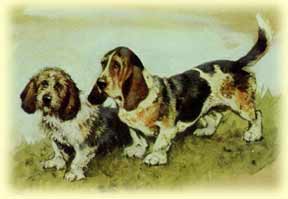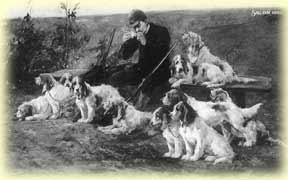

~ A Basic History ~
The PBGV is of ancient descent, in fact his origins can be traced back to the sixteenth century . People often ask, has he got 'terrier' in his background? The answer to this seems to be very vague in all the literature relating to this breed, but a shaggy smaller Basset/Terrier type dog was in existence around the early to middle 1600's where the word 'Hound' meant a dog hunting above the ground and the word 'Terrier' a dog that went underground into burrows etc.

He
seems to have been developed for a particular use (more about this later) over a
period of time from the early Greyhound Griffon types that were involved in the
evolution of deerhounds etc that we know today. As Kings and noblemen in Europe
always had a hunting pack in tow when they traveled around the county there was
much cross breeding between prized dogs who showed great hunting ability
regardless of their type, and colour and if in using these dogs it happened to
improve the offspring's appearance, it was a bonus. One cross which had a great
influence on the appearance of the PBGV and its larger cousins especially with
regard to its colour and coat patterns , was the breeding done with the 'chien
blanc du roi" (translated as the white dog of the king). This was a scent hound
who's height and type was very like the Deerhound/Greyhound and although not a
pure white dog (in fact it ranged in colour from almost pure white to spotted or
patched with red, black, lemon, or badger markings, and strangely even in some
cases, solid black or badger - really confusing the word "white' in the name.)
it had the effect of adding the genes for the white pattern and some of the
other colour patterns to the next generation of early ancestors to pass on in
the breed's development.
The Vendeen is an area of France which is distinguished by its rough terrain,
covered in rocks, thorny brambles and brush. A special type of dog was needed to
hunt in this type of countryside. He needed to be rustic and hardy. (Words that
have stayed with the breed to modern day) He had to possess a thick skin and a
coat that was wiry and rough so as to not be torn to piece by these harsh
conditions. He needed to have a great amount of white colouring on his body so
that he could be easily seen by the hunter and so emerged four rough coated
breeds all similar but slightly different due to their specific uses over the
years from this area.

The
Grand Griffon Vendeen, the Briquet, the Grand Basset Griffon Vendeen and the
Petit Basset Griffon Vendeen who can all be traced back to the original dog of
the area the 'Griffon Vendeen' a powerful ancestor with a rough coat used by
noblemen on horses to hunt large animals such a stags. Unfortunately the
ordinary man and farmer could not afford a horse, and needed a dog which they
could follow on foot and could pursue smaller table fare such as rabbits and
hare, a dog that hunted not by sight but by scent , so gradually an off-shoots
of these larger animals developed by the crossing with smaller scenting dogs of
the era and hence the emergence of the Grand Basset Griffon Vendeen and his
smaller cousin the Petit Basset Griffon Vendeen. The Grand being used for larger
game such as roedeer and wolf, while the Petit was used to trail and drive
smaller game such as rabbit and hare.
The French still to this day are passionate hunters and the art of 'Venery '
(defined as man hunting with the use of a hound) is very much alive in France.
This has kept these rough little hounds very much as they are supposed to be
'rustic and hardy'. They are mainly hunted in packs or braces although work
quite well individually and in Europe and especially France there are still many
packs kept and hunted for competition or just the pleasure.

To learn more about the history of the breed and their Australian History. Click here